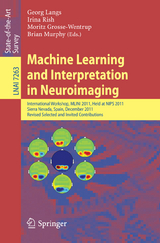Machine Learning and Interpretation in Neuroimaging
Springer Berlin (Verlag)
978-3-642-34712-2 (ISBN)
A Comparative Study of Algorithms for Intra- and Inter-subjects fMRI Decoding.- Beyond Brain Reading: Randomized Sparsity and Clustering to Simultaneously Predict and Identify.- Searchlight Based Feature Extraction.- Looking Outside the Searchlight.- Population Codes Representing Musical Timbre for High-Level fMRI Categorization of Music Genres.- Induction in Neuroscience with Classification: Issues and Solutions.- A New Feature Selection Method Based on Stability Theory - Exploring Parameters Space to Evaluate Classification Accuracy in Neuroimaging Data.- Identification of OCD-Relevant Brain Areas through Multivariate Feature Selection.- Deformation-Invariant Sparse Coding for Modeling Spatial Variability of Functional Patterns in the Brain.- Decoding Complex Cognitive States Online by Manifold Regularization in Real-Time fMRI.- Modality Neutral Techniques for Brain Image Understanding.- How Does the Brain Represent Visual Scenes? A Neuromagnetic Scene Categorization Study.- Finding Consistencies in MEG Responses to Repeated Natural Speech.- Categorized EEG Neurofeedback Performance Unveils Simultaneous fMRI Deep Brain Activation.- Predicting Clinically Definite Multiple Sclerosis from Onset Using SVM.- MKL-Based Sample Enrichment and Customized Outcomes Enable Smaller AD Clinical Trials.- Pairwise Analysis for Longitudinal fMRI Studies.- Non-separable Spatiotemporal Brain Hemodynamics Contain Neural Information.- The Dynamic Beamformer.- Covert Attention as a Paradigm for Subject-Independent Brain-Computer Interfacing.- The Neural Dynamics of Visual Processing in Monkey Extrastriate Cortex: A Comparison between Univariate and Multivariate Techniques.- Statistical Learning for Resting-State fMRI: Successes and Challenges.- Relating Brain Functional Connectivity to Anatomical Connections: Model Selection.- Information-Theoretic Connectivity-Based Cortex Parcellation.- Inferring Brain Networks through Graphical Models with Hidden Variables.- Pitfalls in EEG-BasedBrain Effective Connectivity Analysis.- Data-Driven Modeling of BOLD Drug Response Curves Using Gaussian Process Learning.- Variational Bayesian Learning of Sparse Representations and Its Application in Functional Neuroimaging.- Identification of Functional Clusters in the Striatum Using Infinite Relational Modeling.- A Latent Feature Analysis of the Neural Representation of Conceptual Knowledge.- Real-Time Functional MRI Classification of Brain States Using Markov-SVM Hybrid Models: Peering Inside the rt-fMRI Black Box.- Restoring the Generalizability of SVM Based Decoding in High Dimensional Neuroimage Data.
| Erscheint lt. Verlag | 7.11.2012 |
|---|---|
| Reihe/Serie | Lecture Notes in Artificial Intelligence | Lecture Notes in Computer Science |
| Zusatzinfo | XIV, 266 p. 83 illus. |
| Verlagsort | Berlin |
| Sprache | englisch |
| Maße | 155 x 235 mm |
| Gewicht | 433 g |
| Themenwelt | Informatik ► Datenbanken ► Data Warehouse / Data Mining |
| Informatik ► Grafik / Design ► Digitale Bildverarbeitung | |
| Informatik ► Theorie / Studium ► Künstliche Intelligenz / Robotik | |
| Schlagworte | classification • Data Mining • fMRI • Kernresonanztomographie • Maschinelles Lernen • Multivariate Analyse • multivariate encoding • multivariate pattern analysis (MVPA) • Mustererkennung |
| ISBN-10 | 3-642-34712-6 / 3642347126 |
| ISBN-13 | 978-3-642-34712-2 / 9783642347122 |
| Zustand | Neuware |
| Haben Sie eine Frage zum Produkt? |
aus dem Bereich




